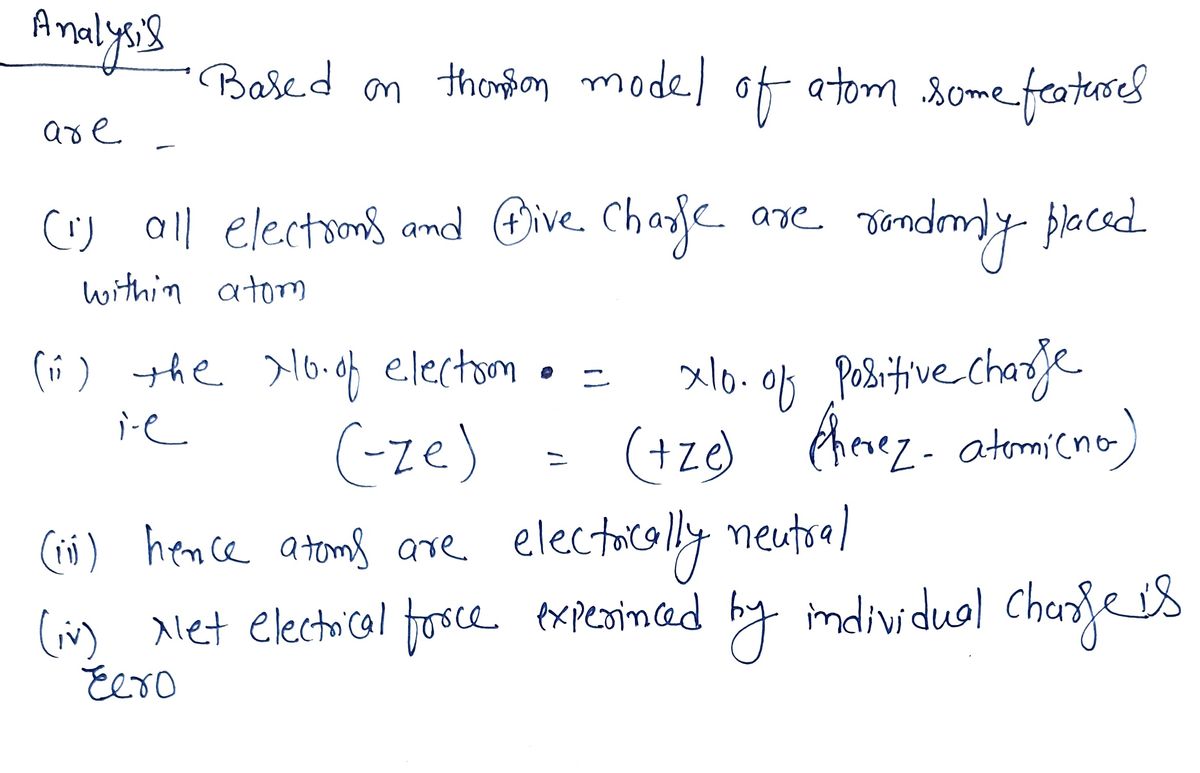Question

Transcribed Image Text:One model of the atom from the early 20th century is the Thomson model, in which a spherical
positive charge, which we'll assume is uniform, contains a number of electrons. Let's further
assume that, on average, the electrons are also uniformly distributed throughout the sphere.
A) Consider one of the electrons. Excluding that electron, what is the net charge of the rest
of the atom?
B) If the atomic sphere has radius R, what is the force acting on that electron a distance r<R
from the center?
c) What type of motion would this electron therefor perform?
R.
Expert Solution
arrow_forward
Step 1

Trending nowThis is a popular solution!
Step by stepSolved in 2 steps with 2 images

Knowledge Booster
Similar questions
- Three point-like charges are placed at the corners of a rectangle as shown in the figure, a = 20.0 cm and b = 66.0 cm. Find the magnitude of the electric force exerted on the charge q1. Let q1 = −2.00 μC, q2= −3.90 μC, q3= −3.70 μC.arrow_forwardFour identical charged particles (q = +10.4 µC) are located on the corners of a rectangle as shown in the figure below. The dimensions of the rectangle are L = 61.2 cm and W = 15.7 cm. (a) Calculate the magnitude of the total electric force exerted on the charge at the lower left corner by the other three charges. N(b) Calculate the direction of the total electric force exerted on the charge at the lower left corner by the other three charges. ° (counterclockwise from the +x-axis)arrow_forwardThe figure below shows three small, charged beads at the corners of an equilateral triangle. Bead A has a charge of 1.65 µC; B has a charge of 5.40 µC; and C has a charge of -5.10 µC. Each side of the triangle is 0.500 m long. What are the magnitude and direction of the net electric force on A? (Enter the magnitude in N and the direction in degrees below the +x-axis.) y 0.500 m 60.0° C N magnitude o below the +x-axis directionarrow_forward
- B2arrow_forwardThe figure below shows three charged particles at the corners of an equilateral triangle. Particle A has a charge of 1.85 µC; B has a charge of 5.40 µC; and C has a charge of -5.00 µC. Each side of the triangle is 0.500 m long. What are the magnitude and direction of the net electric force on A? (Enter the magnitude in N and the direction in degrees below the +x-axis.) B 0.500 m 60.0° A magnitude N direction • below the +x-axisarrow_forwardGiven the arrangement of charged particles in the figure below, find the net electrostatic force on the 9₁ = 5.15-μC charged particle. (Assume q2 = 16.33 µC and 93 = -19.12 μC. Express your answer in vector form.) 7 = X N 91 (-2.00 cm, 0) 93 (1.00 cm, 1.00 cm) 92 (0, -1.00 cm)arrow_forward
- Two small charged metal spheres, A and B, are separated by a distance r. The charge on Sphere A is +2q and the charge on Sphere B is -6q. A r – B If the two spheres are touched together and then separated again by a distance r, what wilIl be the force acting on Sphere A? Select two answers. Choose a magnitude AND a direction.arrow_forwardIn the picture below, the rod is positively charged. Electrically speaking, water is a "polar molecule"; each water molecule can be imagined as a negative charge (the oxygen end) and a positive charge (the hydrogen end), each of approximate magnitude 2e, separated by an approximate distance of 2 x10-1" m. a) Explain how a charged rod can exert an electric force on water molecules that have zero net charge. Include a picture of a typical water molecule in the stream of water adjacent to the rod, showing its orientation relative to the rod. b) If the charge of the rod is +32 nC and that charge is located approximately 2.0 cm from a water molecule in the stream, what is the maximum possible net electric force that the rod could exert on the molecule?arrow_forwardGiven the arrangement of charged particles in the figure below, find the net electrostatic force on the q1 = 5.15-µC charged particle. (Assume q2 = 12.33 µC and q3 = −21.12 µC. Express your answer in vector form.)arrow_forward
arrow_back_ios
arrow_forward_ios